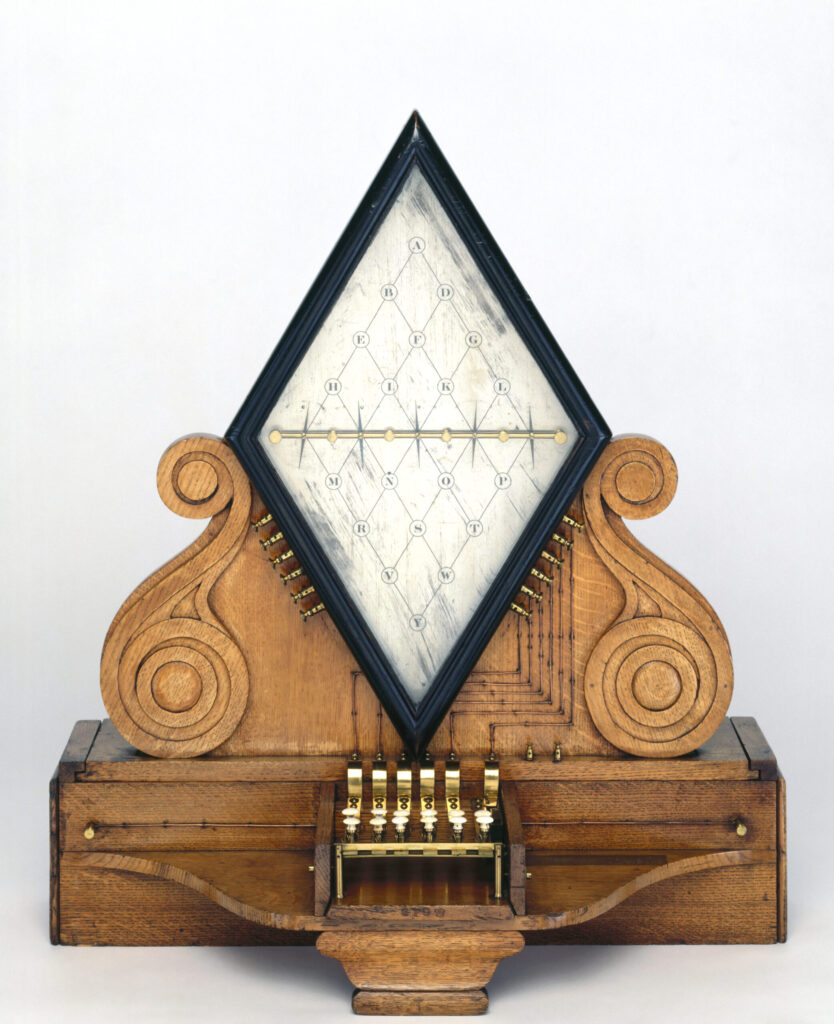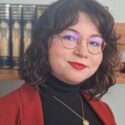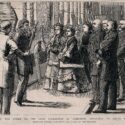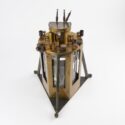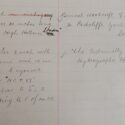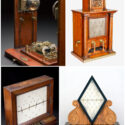1876 and All That: the ‘Special Loan Collection of Scientific Apparatus’ as a case study in crowd-sourced international public science
Abstract
https://dx.doi.org/10.15180/232013Some historians of the ‘Special Loan Collection of Scientific Apparatus’ exhibited in 1876 interpret its principal significance as catalysing the eventual transformation of science collections in the (South) Kensington Museum into London’s present-day Science Museum. Debates about that nexus have not, however, noted that this exhibition was an international crowd-sourced venture in public science. Far from being collection-founding donations, most artefacts displayed were discretionary loans contributed by private citizens, learned societies, instrument makers, universities, engineering companies and state departments from across both the UK and Europe, with most displayed items later returned to their exhibitors. Our paper draws upon the art historiography literature of ‘loan exhibitions’ to consider the 1876 exhibit in (mostly) physical science as part of a growing democratic tradition of resource sharing. This exhibitor-focused approach is illustrated via case studies of two kinds of contributors that did not predominantly have their loans converted to donations: (male) instrument makers and women, especially widows. In that context, we can interpret apparatus lending in 1876 as forms of advertising, memorialising, and just occasionally offloading disused but historically important equipment. It is in such terms that we can better understand why only a small fraction of loaned 1876 apparatus become permanent parts of the South Kensington science collections via such means as state departments discarding obsolete technical equipment.
Keywords
collection, instrument makers, loan, Museum, scientific apparatus, South Kensington Museum, Women
Epigraphs
I doubt very much whether there has ever been any exhibition in England at all approaching in importance or merit the one which is to be held within the next few months.
Lord President of the Council, speech at South Kensington Museum, February 1876, as reported in ‘The Loan Exhibition of Scientific Apparatus’, Nature, 2 March 1876
A very large number of exhibits were sent from abroad. It was supported by the most eminent physicists and scientific men on the Continent. Abroad, it obtained a reputation it never reached at home. It was most unfortunate in its title. ‘‘The Special Loan Collection of Scientific Apparatus’’ was not attractive. The press, for some unaccountable reason, decried it. The general public shunned it, and though 213,196 people visited it, it never acquired the popularity then, which it certainly would acquire now, if it were held again, and given a more telling title. But such priceless treasures as were brought together there will never be brought together again.
Preece, W H, 1882, ‘Electrical exhibitions’, Journal of the Society of Arts, 31, p 81
Introduction
The largest science show ever held in Victorian Britain was the ‘Special Loan Collection of Scientific Apparatus’ exhibited in galleries adjacent to the South Kensington Horticultural Gardens from May to December 1876. This was ostensibly a non-commercial venture in which over 1,200 exhibitors from Britain and a dozen European states between them loaned c. 20,000 items of scientific apparatus (Bud, 2014) to display current and historical research and teaching in the natural sciences (de Clercq, 2002; 2002a). Although smaller than the Great Exhibition held nearby a generation before among much grander glass vistas, the extensively-reported exhibition of the Loan Collection is nevertheless often cited as a significant episode in building the core collections of what later became London’s Science Museum (Follett, 1978, pp 1–3) or at least in (allegedly) establishing the rationale of a British public museum for applied science (Bud, 2014). An extensive literature has explored this originating narrative for the Science Museum (Morris, 2010) with Alison Boyle most recently suggesting that the South Kensington Museum ‘amassed’ items from the 1876 Loan Collection that combined historical apparatus with recent British manufactures (Boyle, 2019, p 488).
Yet, this Loan Collection origins story for the Science Museum is not one to which all denizens of South Kensington have subscribed. For example, no mention is made of the Loan Collection in the 1951 history of the Science Museum by its then director (Sherwood Taylor, 1951), which highlights instead the significant contributions of the pre-existing Patent Museum. To support this scepticism, Robert Bud has more recently highlighted how the Science Museum’s collections date back to the 1860s, and quantitatively that the 1876 Loan Collection’s residue constitutes only three per cent of the current collections (Bud, 2010, p 254). A key source here – not hitherto analysed in detail – is the monumental definitive third edition of the Loan Collection Catalogue that was published in April 1877, long after the public display of the collection closed in December 1876 (Anon, 1877a), following extensive press criticisms of the incomplete first two editions.[2] While that catalogue documents approximately 20,000 separate items, examination of the current Science Museum collections to date has only revealed around 2,180 artefacts relating to that 1876 loan exhibit. So just ten per cent of apparatus in the original 1876 loan display remains to constitute three per cent of the present-day Science Museum collection.[3] In interpreting the broader significance of the 1876 Loan Collection, it would thus be a methodological distortion to treat that small, lingering residue as the chief interest; hence we focus more on the loaning exhibitors to understand better why so little of the Loan collection was retained in South Kensington, never to be gathered together again (Preece, 1882, p 81).
We thus take a more methodologically cautious approach to analysing the broader fate of the 1876 Loan Collection by looking for the first time at the range of exhibitors in its final Catalogue (Anon 1877a); the relevant 1876 ledgers in Science Museum archives, and at a broader range of contemporary newspaper opinions to that covered by Bud and de Clercq. Two questions arise in such an approach, firstly: what can be said about that majority ninety per cent of (c. 18,000) items that were not donated but instead returned to their owners or discarded? That question must be asked in relation to the motives of their exhibitors in order to avoid the retrospective teleological bias of focusing only on the retained objects. Then, if we ask how a temporary collection that was avowedly loaned by thousands of private exhibitors could have been the progenitor of a permanent collection, we need to adopt the perspective of art historians on the prior tradition of loan collections in decorative artefacts that already had a precedent at South Kensington in Henry Cole’s building of the art collections. From that perspective, it emerges how the public soliciting of loan objects was an indirect strategy adopted by museums to develop public interest in creating collections both among prospective lenders and potential audiences. That way we can see how past collections in art and science alike could be shaped by a dialogue between publics and curators, not always at the sole discretion of the latter as has been most commonly assumed (Alberti, 2018).
A second key question is: why did the organisers of the 1876 Loan Collection specifically solicit apparatus in the physical sciences? – a question not directly addressed in previous historical sources. To answer that, we must explore how the 1874 Devonshire Commission report judged the South Kensington Museum’s science collections to be an unfortunate miscellany of contingent inheritances, with a dire deficiency of any objects relating to the key contemporary growth in the sciences of chemistry, geology, mechanics and physics. To look more carefully at how objects in the physical sciences were drawn from public sources to a loan display in South Kensington, we here offer a pair of pilot case studies based on digital searches undertaken in pandemic conditions by two student co-authors, Nela Spurna and Alexander King. They looked at two contributor groups whose artefacts were largely not retained upon the Loan Collection’s dispersal in early 1877: scientific instrument makers, an exhibitor constituency courted by the Collections’ organisers; and female exhibitors, whose contributions were not so obviously solicited. It is from that perspective that we explore the 1876 Collection as an early crowd-sourced public display of science, whereby individual exhibitors could attract new audiences to their artefact-based practice or preoccupations in natural science, without longer-term donation being the presumptive motivation. While touching on some events in 1877, in the aftermath of the Loan Collection’s dispersal, we do not have the scope here to look at any later developments.
After exploring those two key questions outlined above, we then proceed to (re-)examine the less-commonly addressed primary sources just mentioned to present those two case studies, and only then comment on some preliminary evidence of why some specific domains of the 1876 Loan Collection ended up staying in South Kensington.
Why the focus on physical science?
The 1876 Loan Collection was a vast multinational enterprise of public science that occurred in the decade preceding the focus of Frank Turner’s classic study of public science from 1880 (Turner, 1980). This public-sourced display in South Kensington focused on the apparatus of the physical, chemical, mathematical and engineering sciences, as well as laboratory biology. Such was the scale and ambition of the Collection that the national organising committee consisted of no fewer than 134 of the most eminent British men of (mostly physical) science chaired by the President of the Royal Society, Joseph Hooker, with the Royal Society’s treasurer, William Spottiswoode, managing the finances, and senior civic figures such as Sir Henry Cole, recently retired as Secretary and Director of the Science and Art Department. Following Britain’s lead, European coordinating committees soon formed in Belgium, France, Germany, Italy, Netherlands, Norway, Russia, Switzerland, Austro-Hungary, Spain and the USA. The German committee alone consisted of 21 members from Berlin, with 37 from other German cities. This was no parochial English affair then, but a major international scientific collaboration coordinated by Britain, showing how the continent’s oft-warring nations could jointly illustrate the power and value of instrumentation in the physical sciences.
As is well known, the immediate prompt for the Loan Collection project was the 1874 report of the Royal Devonshire Commission on Scientific Instruction and the Advancement of Science to the British government (Bud, 2014). This highlighted a major absence in the nation’s collections that previous historians have noted only in passing: while London boasted museums of botany, geology, and archaeology, there was little discernible physical science among the awkwardly contingent miscellanea that made up the South Kensington Museum’s science collections. The commissioners’ report contrasted the highly developed and systematic nature of the Museum’s art collections with this list of eight collections bequeathed or abandoned to the care of South Kensington (with originating date where specified): the Food Collection (1858); the Animal Products Collection (1851); the Structure and Building Materials Collection (1851); Models of Machinery, Ships, and Military and Naval Appliances; Collections illustrating Economic Entomology and Forestry; Collections illustrating Fish Culture; the Educational Collections (1854, 1862, 1871); and the Patent Museum (1851) (Devonshire Commission, 1874, Section 65, p 11).
The commissioners ‘regretted’ that there were ‘no National Collection of the Instruments used in the Investigation of Mechanical, Chemical, or Physical Laws’ even though such collections would clearly be ‘of great importance to persons interested in the Experimental Sciences’. This was especially concerning given the scale of ‘daily increasing demand’ for such knowledge especially among teachers of experimental science: in 1874 there was ‘no place in the country’ where such teachers could inspect a ‘Physical Instrument not in [their] possession’ as a teacher of literature would consult a library, or a natural history teacher a specimen cabinet. Indeed, by contrast, the Commissioners observed that on the continent of Europe such collections of scientific apparatus were not only ‘available to view’ but used in lectures ‘accessible to workmen’ in ways that ‘exerted a very beneficial influence on the development of the skill of artisans’ that were employed in making such instruments (Devonshire Commission, 1874, p 13).
This public absence of physical science apparatus was all the more egregious given that, in 1874, the new Physical Society of London had begun meeting at the Science Schools adjacent to the South Kensington Museum to discuss recent practical innovations in physical science and their use in education (Gooday, 2020). It is thus no surprise that the Physical Society’s leading members, notably its founding leader and Professor of Physics, Frederick Guthrie, were all invited to join the Loan Collection’s 134-person organising committee. This proved to be an effective way of ensuring that loans were solicited to the 1876 collection in the domains of physics, chemistry, geology, geography, mechanics, mathematics, mineralogy, and mining, while also including a material culture of microscopy pertaining to numerous domains, such as biology.
And why a Loan Collection?
Why then propose a loan strategy to build up a permanent collection? Prima facie this would seem self-contradictory or at least rather opportunist. Yet it was not so strange: this was a strategy borrowed from the fine art world at a time when collections of art and science were closely interconnected, as manifest in the South Kensington Museum’s collections of both (until the fine arts were redesignated as the Victoria and Albert Museum from 1899). On the one hand, loan collections enabled a more inclusive approach to who was permitted to exhibit their valuable material culture, with private collectors able to display their property, thereby extending the scope of institutionalised gallery-museum collections. And on the other hand, such loan exhibitions encouraged a broader public to visit displays of artwork that regularly changed as they were borrowed on a short-term basis from eminent art collectors. While this loaning practice began at the South Kensington Museum in the 1850s under the aegis of Henry Cole (Eatwell, 2000, pp 21–26), it accelerated in popularity arguably for socio-political reasons. An enlargement in the enfranchised (male) population in England and Wales agreed by Parliament in 1867 entailed a strong need to educate those newly entitled to vote. Education in art and science alike were both relevant for the informed and responsible election of governments, and loan collections answered this need. At the time that the reformed franchise act came into operation in January 1869, art galleries and museums were not set up for broad democratic inclusive participation. Thus, Schleiffenbaum argues that ‘loan collections’ enabled the Royal Academy of Arts to open up its galleries to new showings, temporarily displacing their permanent collections, with opportunities for a much wider public to be educated by this broad vista of creativity (Schleiffenbaum, 2013/2014).
Such a loan-oriented approach to developing collections enabled the broadening of public education without putting financial pressure on the government, nor any obligation on state bureaucracies to organise museums. Instead, the resources that the nation already owned, distributed across the moneyed classes, could be shared briefly with less privileged populations, to normalise the acquisition of both high culture and new knowledge of the natural world. Importantly, while there was no explicit expectation that such ‘loan collections’ would transmute into permanent donations, for Victorian technocrats, the display of loan collections would build up public interest in the loaned subject area. Popular demand thereby created could in turn generate pressure for a centralised acquisition of artefacts by the state or other private benefactions by, for example, philanthropists. Only by that somewhat indirect means could a permanent collection arise from a loan collection (Ferry, 2007).
As Ann Eatwell (2000) has emphasised, this strategic use of loan collections had been adopted by Henry Cole, the Director of the South Kensington Museum, as a means to build up the art collection from the mid-1850s, with elite collectors making occasional donations to enlarge the national repository of art. Eatwell points out that this strategy for turning art loans into permanent holdings was sustained up to 1932 in the Victoria and Albert Museum by which time its director deemed it unnecessary as that museum had reached full ‘maturity’. Eatwell argues that loaning attained the peak of fashion in the mid-1870s, with the South Kensington Museum enjoying art loans from ‘the Queen, the Prince of Wales, Lords and Ladies, Viscounts and countesses, officers, clergymen, collectors, dealers, designers and manufacturers’. In fact, Eatwell highlights that as many as one in six lenders (68 of 407) to the Museum’s Art Division in 1873 were women (Eatwell, 2000, p 29).
As we shall see below, the (slightly different) demographic profile of lenders to the 1876 Loan Collection of Scientific Apparatus also included wealthy elites and industrial manufacturers, as well as a small proportion of women. There were significant differences, however, in both the priority given to loan collections – much less frequently in the science division than in the arts – and with science loans actively sought far beyond British shores.
Soliciting loans of scientific apparatus
Given Henry Cole’s pursuit of a loan strategy for developing the South Kensington’s art collections, we can thus understand why the same approach was adopted to develop the counterpart science collections: on 22 January 1875, the Lords of the Committee of Council on Education laid out a plan to address the deficit in physical sciences by a Loan Collection of Scientific Apparatus. This was to include not only ‘apparatus for teaching and for investigation’, but also ‘such as possessed historic interest on account of the persons by whom, or the researches [sic] in which, it had been employed’ (Anon, 1877a, p ix). To secure this plan, the Lords invited those 134 men of science and political-industrial allies to join the loan committee and planning sub-committees: Section I – Mechanics (including mathematics and mechanical drawing); Section II – Physics; Section III – Chemistry; Section IV – Geography, Geology, and Mineralogy; and Section V – Biology. Henry Cole himself was notably involved in both the Loan Committee and subcommittees for Section I and III. The full Loan Committee met for the first time on 13 February 1875 and evidently shared the Lords’ support for the venture to promote a national museum of science akin to those on the continent (for example, the Musée des Arts et Metiers in Paris). This would presumptively bring two kinds of benefit, tending both to the ‘advancement of science’, and to be ‘of great service to the industrial progress’ of the United Kingdom, albeit ruling that exhibitors could not overtly treat this as a commercial opportunity as had been characteristic of traditional industrial exhibitions (such as those in 1851 and 1862).
With a view to those twin goals, the organisers of loan exhibitions in art and science alike carefully specified the knowledge categories in which loans should be offered by prospective exhibitors. For loan art exhibitions in the early 1870s, art historians suggest that such categories were managed by numerical constraint – only the very best examples (however judged) of each category were displayed in galleries so that the experience was focused and not overwhelming. By contrast, for the 1876 Loan Exhibition of Scientific Apparatus, a very clear schema of preferred loan subjects was laid out. All but the very last of these categories lay in the physical sciences for reasons laid out above: Arithmetic; Geometry; Measurement; Kinematics, Statics and Dynamics; Molecular Physics; Sound; Light; Heat; Magnetism; Electricity; Astronomy; Applied Mechanics; Chemistry; Meteorology; Geography; Geology and Mining; Mineralogy; Crystallography, and Biology (laboratory microscopes and so on). And unlike for an art loan collection, the 1876 exhibition of science apparatus was not limited in number, nor just to loans from British territories.
Indeed, in contrast to domestic art loan exhibits, committee invitations were distributed internationally by embassies in Germany, France, Russia, Austria-Hungary, Italy, Belgium, Netherlands, Sweden, Spain, Switzerland and the USA. Strikingly, the British government undertook to cover the costs of all objects being brought to the exhibition. With the representation of further subcommittees in those nations (especially a huge German contingent), an avalanche of thousands of items headed towards South Kensington over the next four months (and more) forcing a postponement of the Loan Collection’s opening from March to May 1876, which was itself marked by Queen Victoria’s presence. Her visit was illustrated by The Graphic in a scenario of John Tyndall, Professor at the Royal Institution, and Board of Trade authority on lighthouse technology, demonstrating the action of a foghorn to the Queen and her entourage (see Figure 1), including her daughter, the future Empress of Germany, who helped to coordinate the very substantial German contribution to the Loan Collection.[4] Notably, although six foghorns featured in the Loan Collection to illustrate the science of sound, symptomatically of the overall exhibit’s eventual return to their lenders, none of these foghorns were apparently incorporated into the Museum’s permanent collections (Anon, 1877a, p 532).
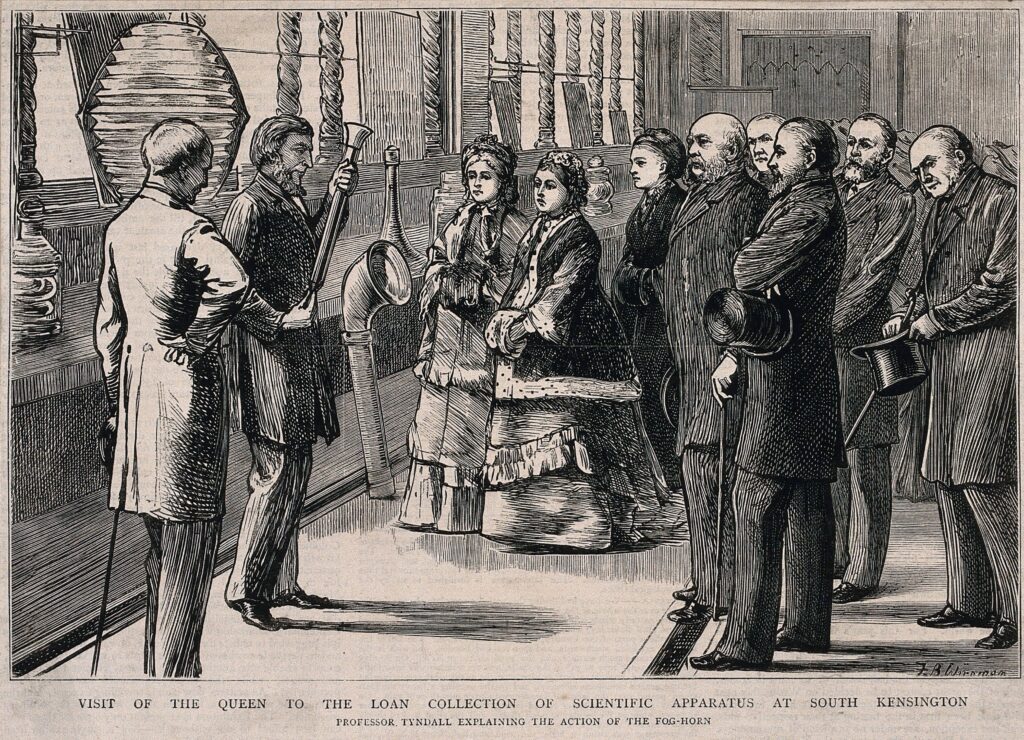
So many thousands of items were proffered for the Loan Collection of Scientific Apparatus from European sources that the late arrival of many entailed that the final definitive version of the Catalogue could not be published until April 1877, a full four months after the exhibition had closed. The (unnamed) editors of this Catalogue of the Special Loan Collection of Scientific Apparatus at the South Kensington Museum did not comment on why more than 1,200 exhibitors had chosen to loan around 20,000 items to the collection, nor why these offers of loans were all apparently accepted. The implication was clearly that this was a very grand public participatory event – ‘crowd-sourced’ in twenty-first century jargon. Instead, the editors dedicated thirty-two pages to documenting each and every primary ‘contributor’ by name and address, indicating on which catalogue page their loaned objects were listed (Anon, 1877a, xxix–lviii, pp 26–58). These were listed by nation, with all nations mentioned above included, although while representatives from the USA had initially shown interest, that nation’s attention was swiftly dedicated instead to its own spectacular (and indeed better-known) 1876 Centennial Exhibition in Philadelphia.
When we contemplate the huge array of international scientific apparatus thus loaned to the collection, it is striking that unlike the focused approach of art galleries in loan collections, inclusivity not elitism was the watchword at South Kensington in 1876. No indications have yet appeared of offered loans being declined by the 1876 collection organisers, although future archival research might reveal evidence of this.[5]
Who were the exhibitors for the 1876 Loan Collection?
The British committee organising the Loan Collection approached both the national public and sympathetic owners of scientific apparatus across the European continent: ‘All who [were] in possession of rare or valuable instruments, especially those of historic interest’ were asked to contact their local government bodies or the South Kensington Museum and ‘place [the objects] at their disposal’ (Anon, 1876e, p 2). Given the above-specified categories, the British public and press responded swiftly. From a systematic search across digital UK newspapers for references to the planned loan collections in the first months of 1876, it is evident that responses to the call were received from across the nation. The Tamworth Herald highlighted on 4 March 1876 a point of great long-term import: that it was government departments and state institutions of science which had made the most significant promises to loan:
The Admiralty will furnish a complete model of a surveying ship; the Post-office a number of telegraphic instruments illustrating the progress and development of the modes of transmitting information by electricity. The Trinity House, Ordnance Survey, Royal Observatory, Geological Survey, and a host of other organisations, will send in apparatus peculiar to the work of each, not any elaborate and complicated, but all interesting in their way (Anon, 1876e, p 2).
The Huddersfield Chronicle noted similarly that The Institute of Naval Architects had made available ‘a collection of models, apparatus, and drawings, illustrating the history of naval architecture and marine engineering’ (Anon, 1876f, p 3). A Chelmsford counterpart reported that plans for related conferences were afoot (Anon, 1876d, p 7): at the first of these held in mid-May 1876, the Royal Society’s treasurer, William Spottiswoode, commended the British organisers’ hard work and highlighted chiefly the significant ‘instruments of historic interest’ in the Loan Collection (Anon, 1876h, p 3; de Clercq, 2002).
Although there is not space in this short article to analyse in depth the detailed demographics of those of a dozen nations lending to the 1876 Collection, we can at least loosely categorise most of them as follows: bodies of state, national and local museums; academic institutions; learned societies; observatories; engineering companies; telegraphic companies; instrument makers; individual academics; wealthy private collectors; as well as many other private individuals (Anon, 1877a xxix-lviii). The majority of loans seem to have come from those latter domains, including widows and spouses of scientific men as outlined further below. The organisers’ initial plans had evidently not anticipated the success of their appeal to such British and European lenders; indeed, in ways not discussed by previous historians, the majority of scientific apparatus loans actually came from outside the UK. As the Edinburgh Evening News noted: ‘So large were the contributions from abroad that it was found necessary to increase the space at first granted, and it was impossible to complete the placing and cataloguing in time’ (Anon, 1876h).
Given the enormity of the scale of loans, some categories were clearly a challenge for the subcommittees to manage. For example, a total of 19 slide rules were supplied from various sources to demonstrate arithmetic, and no fewer than 47 miners’ safety lamps were displayed. And the many photographs of scientific apparatus that were offered evidently proved awkward to categorise, so these visual artefacts were generally assimilated into the ‘etc’ catch-all category of ‘Models etc’. We will see this below in the examples of Winifred Lockyer’s two photographic loans. Notwithstanding these infelicities, the sheer physical extent of the exhibition apparently ‘exceeded the best hopes of its originators’ and on those grounds its organisers considered it a great success (Anon, 1876h, p 3). Even so the extent to which visitors and the contemporary Press considered the exhibition of the 1876 Loan Collection to be any kind of success is somewhat moot and indeed was long ago questioned by Harry Butterworth (Butterworth, 1968, Vol.1, 196–98; Vol.2, 251–252). Indeed given the rather mixed review of the Loan Collection offered by William Preece as Post Office telecommunications chief six years later (see second epigraph above), a fuller and more nuanced understanding of the Loan Collection’s public reception clearly requires much further research (Preece, 1882, p 81).
Instrument makers as exhibitors at the Loan Collection
For some organisers, such as William Spottiswoode, the purpose of the 1876 Loan Collection was primarily historical in interest, showing instruments that were important for past canonical discoveries in the sciences. In such initiatives, we can see one source of the notion that a national museum of science should have more of a historical focus than contemporary. Yet that was not a majority view; even though De Clercq’s account focuses on objects of ‘historical’ value, he himself noted of the 1876 Loan Collection that the majority of loan exhibits were contemporary innovations (2002, p 11). As the Loan Committee had indicated in its call for display items in early 1876, the exhibition at South Kensington was not for commercial purposes; the majority of instruments displayed were from private collections of science practitioners and institutions. Indeed, it is revealing that only around one fifth of the exhibitors overall were involved in manufacture and/or trade of recently made apparatus for immediate use in teaching, research or technical practice: the proportions were 138 out of the 647 of UK exhibitors (21 per cent) and 53 out of 318 German exhibitors (17 per cent), of which just 31 were instrument makers (see below).
In this industrial sector, the preponderant constituency was commercial instrument makers, and their displays were indeed prominent at the 1876 Loan Exhibition – if nowhere near as prominent in the subsequent donations to the South Kensington Museum. The coverage of ‘scientific apparatus’ on display was very broad, encompassing experimental models, photographs, educational objects, and replicas. But even a cursory glance at the final Catalogue of the Special Loan Collection of Scientific Apparatus at the South Kensington Museum (Anon, 1877a) reveals that scientific instruments per se, usually used directly for experimental purposes, constituted a particularly common object class. For example, lists of barometers and thermometers make up a substantial part of the Catalogue’s meteorological section (Anon, 1877a, xx, xxiv, 90, 92–94, 107, 177, etc); for chemistry, in Section 13 of the Catalogue there is much apparatus for specialist experiments (Anon, 1877a, pp 563–672), and galvanometers and electrometers were very common forms of electrical measuring equipment (Anon, 1877a, pp 298–390).
To focus on the loaning of these instruments in 1876, we should note that the vast majority of instrument maker firms involved were led by male craftsmen and small business owners whose economic and social status generally differed substantially from that of university-educated and independently wealthy members of the Loan Committee’s scientific elite (Anon, 1877a, p ix-xi). These business people looked to exhibitions as a way to maximise the visibility of their products, whether or not sales were permitted, and loaned their equipment accordingly. Thus, in The Precision Makers, Mari Williams (1993) has shown how instrument makers saw the strategic importance of multinational exhibitions in this period for shaping the manufacture and global markets of scientific instruments. Williams’ account does not, however, discuss the 1876 exhibition of Scientific Apparatus, so its significance for instrument manufacturers is explored for the first time in what follows.
Even if no direct purchases were permissible (as would have been the case at a standard industrial exhibit), the 1876 Loan Collection acted tacitly as a trade show for scientific instrument makers to show off their latest wares to large audiences of prospective customers. As a result, some of the most prominent instrument makers in Britain loaned their equipment: the Elliott brothers, J J Hicks, Negretti & Zambra, and L P Casella were among these. All these loaned substantial amounts to the exhibition: the Elliott Brothers’ equipment was mentioned on 57 separate pages in the published Catalogue. While some of these firms displayed older designs, many of their designs were new, e.g., entry 2827a extolls the virtues of enamelling in enabling scientific and medical research, as well as the fact that Negretti & Zambra invented the enamelling process (Anon, 1877a, pp 686–7). Such new instruments were apparently not subsequently donated to the Museum, but presumably returned to their makers for subsequent commercial sale. However, in the two cases that we explore next of James White and Max Thomas Edelmann we can see how instrument makers could have some different relationships in both their character and involvement in the exhibition.
One exception to the pattern of instrument-making exhibitors declining to donate, was the Scottish instrument-maker James White (1824–1884), whose Glasgow-based business specialised in optical and electrical laboratory equipment. Well-known for his close work with Sir William Thomson (later Lord Kelvin) in early transatlantic telegraph cable instruments (Smith, 1998), no fewer than 43 of their instruments were exhibited at the 1876 Loan Exhibition, (Anon, 1877a, xli,11,12, 50, 152, 300, 321, 329–331, 335, 336, 342, 349, 371, 373, 445, 451, 770, 776–779). Only two of these, however, explicitly cited White as the exhibitor. These were: ‘1413a. Sir Wm. Thomson’s Quadrant Electrometer, with most complete adjustments and of most perfect construction, James White. A descriptive pamphlet accompanies the instrument’,[6] and ‘1413b. Sir William Thomson’s Portable Electrometer, with most complete adjustments, and of most perfect construction. James White’[7] (Anon, 1877a, 329). See Figure 2 and Figure 3 for illustrations of these instruments in the current Science Museum collections.
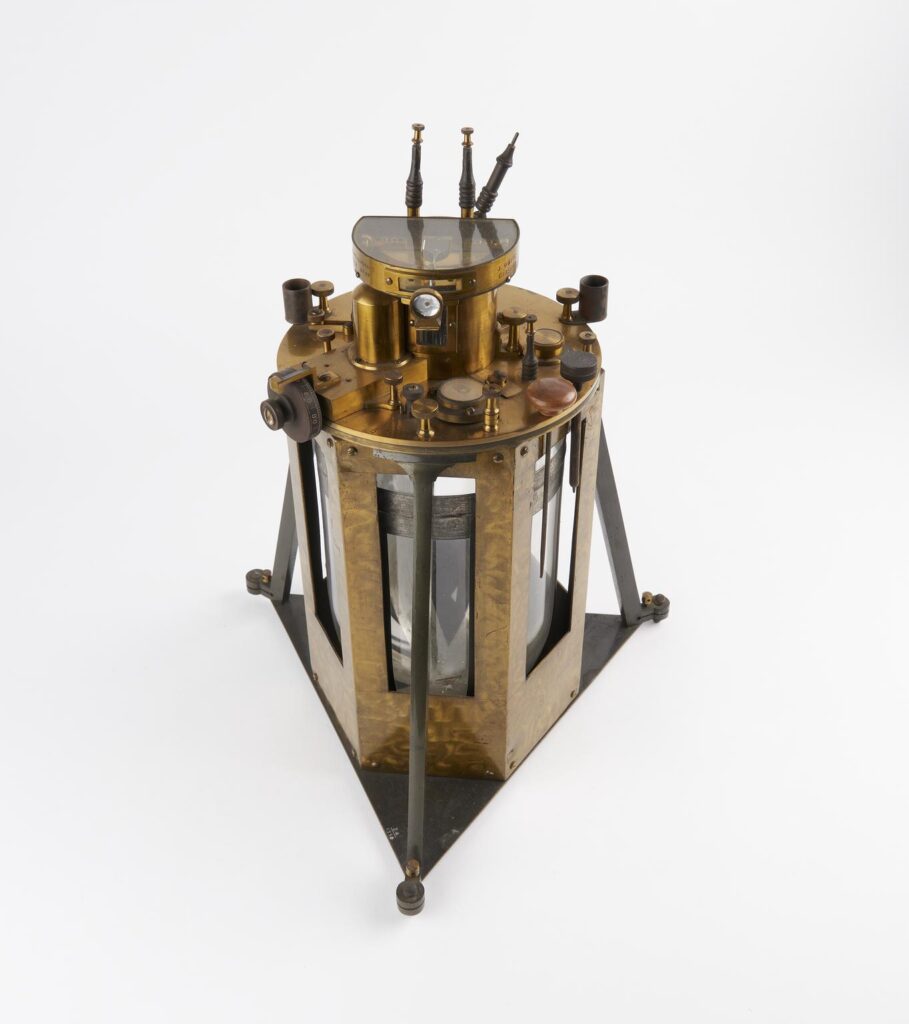
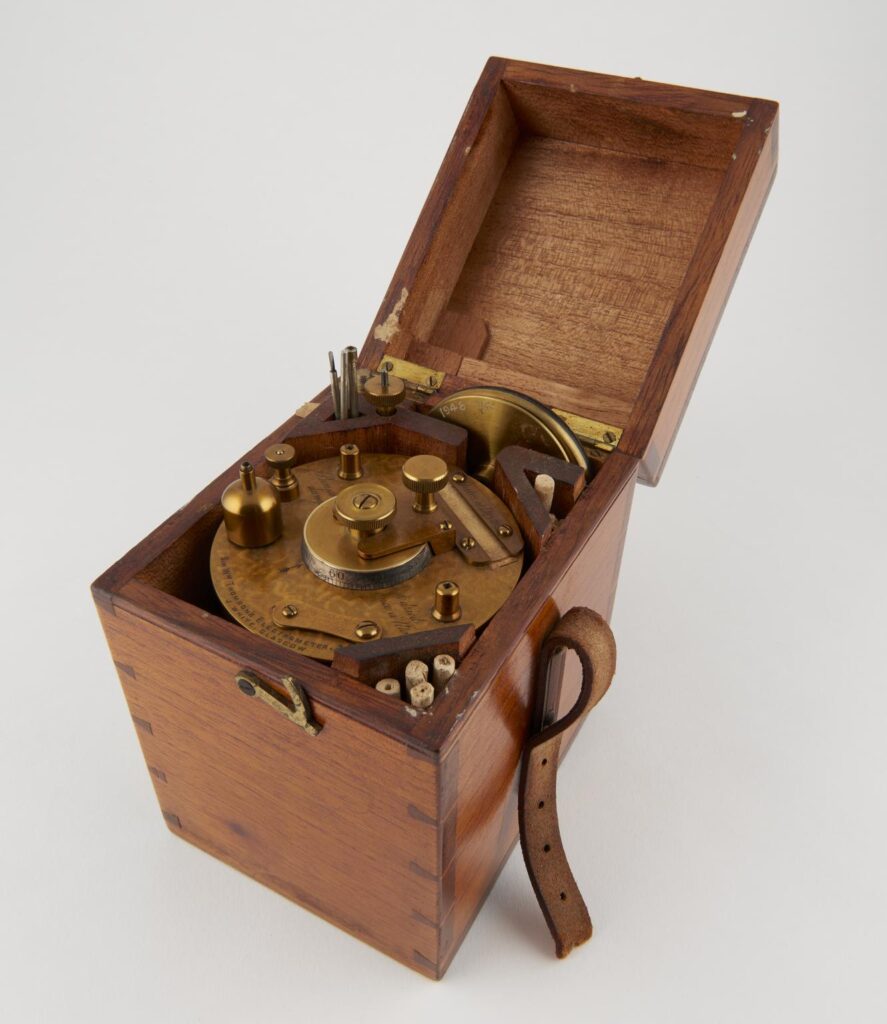
Unusually for the instrument-maker constituency, many of these objects appear to have been donated by them at the close of the Loan Collection,[8] most notably those of a historic variety that by 1876 had been superseded in commercial practice. To be specific, most of their collaboratively produced donated objects are recorded in the Science Museum ledgers as Thomson’s donations, with only a handful listed with White as the donor, and most from the early stages of the transoceanic telegraph.[9] Thus we can see – pace Boyle (2019) – how the donation of Loan Collection apparatus post-1876 would tend to feature more historical artefacts than contemporary, thereby supporting the emphasis that de Clercq (2002, 2002a) has placed on the primacy of the former.
Given the predominantly international array of loans at the 1876 Collection, a useful comparison can be made with the German contribution as the largest non-UK presence at the 1876 exhibition – no fewer than 31 or so German instrument makers were represented. Indeed, de Clercq (2002b, p 18) notes that the German contingent alone produced its own translation of the 1876 Catalogue, as well as a German-language collection of essays relating specifically to scientific instruments at the exhibition (Anon, 1877a, pp xlvi–liii). From this extensive array, a maker whose activities are illustrative of themes previously discussed is the Munich-based Max Thomas Edelmann (1845–1913), affiliated with the Polytechnic School there.[10] Edelmann manufactured medical equipment, optical instruments, and electrical instruments but would become most known in the early twentieth century for his manufacture of acoustic scientific instruments, most notably precision tonometers and the Galton Whistle.
Edelmann’s tonometers were a series of tuning forks that could be used to test the hearing ranges of a subject, and the version of the Galton Whistle he designed was intended for a similar purpose. Edelmann is a significant figure in the field of acoustic medicine. David Pantalony (2020) and Agnes Bauer (2019) have argued that Edelmann and the instruments he manufactured played an important role in the development of the psychology of hearing in the early twentieth century. While the 1876 exhibition took place relatively early in Edelmann’s career, as a manufacturer he still donated several objects (in addition to those mentioned above as purchased by the Museum). Many of these remain in the Science Museum’s collection, and available to view online.[11] Also notable about Edelmann is that almost all the objects he donated were electrical in nature, differing from the acoustic equipment for which he would later become best known, such as the Galton Whistle, a device for testing the capacity for hearing higher frequency sounds.
To conclude this section, we may note that while major contemporary instrument manufacturers, both UK and European and domestic, had many objects on display at the exhibition for commercial reasons, only a relatively small proportion of those can be found now in the Science Museum’s collections. This reflects the diversity of their motivations for display. A comparable diversity of motivation for loaning is apparent in the next section, where we look at a rather different sub-category of contributors to the 1876 Special Collection of Loan Apparatus.
Women as loan exhibitors
Characteristically, previous histories of the 1876 Loan Collection have presumed all key participants, apart from Queen Victoria, to be male. Yet we know from the extensive literature on art collections and museums more generally that women were a substantial presence in both contributing artefacts and constituting visiting audiences to museums (Hill, 2016; Avery-Quash and Riding, 2020). What follows is the first attempt to map the involvement of the 31 women mentioned in the final Catalogue, five of whom are studied in detail below on the grounds that artefacts associated with them in the Loan Collection were most numerous among their category and/or most prominent in long-term preservation. From looking at the Catalogue (Anon, 1877a), the Exhibition Handbook (Anon, 1876i), and the Science Museum’s ledgers from 1876,[12] we find that most of the women directly mentioned as lenders in the exhibition Catalogue were British, with a few also from France, Germany, and Russia. Most were from a specific demographic: widows of scientists and engineers, which can inform our discussion of their motives for loaning and their objects for display.
Among these were several famous names, such as Mrs Faraday and Mrs Lockyer, whose appellations are both characterised in the conventional marital format of spousal surname. The remaining women only feature indirectly in the catalogue with a passing mention in object descriptions. Their names usually warranted an honorary mention either due to their aristocratic status or their involvement in the retrieval or construction of the object. This includes several artists and at least two female inventors, notably Mrs Henrietta Vansittart, inventor (drawing on her father’s prior work) of the Lowe-Vansittart marine propeller, then held by the Patent Office Museum (Rees Koerner, 2021).[13] Another example is the Camera Obscura ‘given by Sir Joshua Reynolds to Lady Yates whose great grand-daughter, Mrs J. R. Harrison’ presented it to the South Kensington Museum in May 1875 (Anon, 1877a, p 205).
Most of the women we discuss here loaned objects that formerly belonged to and/or were made by their male family members, rather than the products of their own labour. This presents new insights into how women participated in debates over what constituted ‘science worthy of display’ and the curatorial authority they held over spousal legacies. In this way, we can add to the growing literature that has situated women much more centrally as active agents in the history of science’s material culture (Jones, Martin and Wolf, 2022). In Anna Adamek’s gender comparison of donations to the Canada Science and Technology Museum (CSTM), she found that, although women made up the majority of the CSTM’s adult visitors, ‘very little’ had hitherto been written on women’s roles in that museum (Adamek and Gann, 2018, p 51). In analysing CSTM’s collection database, she found that women tended only to donate artefacts related to their kinfolk’s work, while men typically donated artefacts that related to their own handiwork (Ibid, pp 53–54). This insight gives us a valuable comparative framework to consider how the 1876 Loan exhibition featured women’s loaned objects.
The five women[14] chosen for detailed study here either loaned a significant number of objects to the 1876 Collection (e.g., Mrs Faraday) or the objects they donated (probably) remain in the Science Museum today (Mrs Grantham and indirectly Mrs Griesbach), or they loaned handiwork related directly or indirectly to their own areas of expertise (Mrs Lockyer and Mrs Cowper). This research method revealed that the only item directly listed from a female contributor to the 1876 Loan Collection that is still in the Science Museum’s collection is Mrs Grantham’s loan of her husband’s Model of Patent Steam Tramway Car, with the Lowe-Vansittart propeller present in virtue of an earlier donation in 1874.[15]
The table below lists all the objects contributed by our five women as documented by the 1876 Loan Collection Catalogue 3rd edition (1877a) and then any that became permanent acquisitions as recorded in the Science Museum ledgers, thereby illustrating what proportion of these were kept. Where ‘X’ is used in place of a reference number, the object could not be found in the record of acquisitions; and bracketed reference numbers denote objects that have apparently been deaccessioned.
| CONTRIBUTOR | OBJECT | 1876 Loan Collection Catalogue Reference | Science Museum Ledger Reference (if any) | |
| 1 | Mrs Sarah Barnard (Mrs Faraday) | Metallo-Chrome. A specimen prepared by Nobili, and presented by him to the Royal Institution. | 2434 | X |
| 2 | Mrs Sarah Barnard (Mrs Faraday) | Diagrams of magnetic Curves, prepared by Faraday. | 1739 | X |
| 3 | Mrs Sarah Barnard (Mrs Faraday) | Coils and Helices, used by Faraday in his magneto-electric researches. | 1740 | X |
| 4 | Mrs Sarah Barnard (Mrs Faraday) | Model frequently used by Faraday during his re-searches on the rotation of a ray of polarised light by electricity and magnetism. | 1741 | X |
| 5 | Mrs Sarah Barnard (Mrs Faraday) | Block of Glass pierced by sparks from an induction coil. Presented to Faraday by H. Ruhmkorff. 1861. | 1742 | X |
| 6 | Mrs Isabel Agnes Cowper (Mrs Charles Cowper) | Daguerreotype Portrait of Faraday. | 1232a | X |
| 7 | Mrs Isabel Agnes Cowper (Mrs Charles Cowper) | Daguerreotype Portrait of Faraday and Brand. | 1232b | X |
| 8 | Mrs Miriam Griesbach | Monochord with apparatus for printing and registering, on tripod stand (an engraving is also exhibited). | X | (1876-277) |
| 9 | Mrs Miriam Griesbach | Copy of Five Cubic feet Gas-measuring Standard, made of anti-corrosive metal, by G. Glover and Co. | 197 | X |
| 10 | Mrs Miriam Griesbach | Apparatus on the principle of Savant’s wheel for producing the notes of a common chord. | X | (1876-318) |
| 11 | Mrs Miriam Griesbach | Monochord which measures to the 1/2000th inch. | X | 1876-594 |
| 12 | Mrs Miriam Griesbach | Monochord phonometer giving 12 equally tempered sounds in the octave; with bow. | X | 1876-596 |
| 13 | Mrs Miriam Griesbach | Paper records: Handel’s pitch. Society of arts pitch. | X | (1876-664) |
| 14 | Mrs Miriam Griesbach | Set of flute pipes (13) and reeds (4) for the production of high notes with bellows attached. | X | (1876-691) |
| 15 | Mrs Miriam Griesbach | Glass case for 1876-691. | X | (1876-692) |
| 16 | Mrs Miriam Griesbach | Instrument labelled Harmonic Octaves and Harmonic Sevenths. | X | (1876-967) |
| 17 | Mrs Miriam Griesbach | Monochord. | X | (1876-968) |
| 18 | Mrs Miriam Griesbach | Bow. | X | (1876-969) |
| 19 | Mrs Miriam Griesbach | Magnifying Glass. | X | (1876-970) |
| 20 | Mrs Miriam Griesbach | Movable Scale. | X | (1876-971) |
| 21 | Mrs Miriam Griesbach | Movable Clip. | X | (1876-972) |
| 22 | Mrs Miriam Griesbach | Box with Beads. | X | (1876-973) |
| 23 | Mrs Miriam Griesbach | Mahogany board fitted with cog wheels and rope. | X | (1876-974 |
| 24 | Mrs Miriam Griesbach | Mahogany board fitted with sliding piece. | X | (1876-975) |
| 25 | Mrs Winifred James (Mrs Norman Lockyer) | Photographs of the Old Astronomical Circles at Delhi. | 1912e | X |
| 26 | Mrs Winifred James (Mrs Norman Lockyer) | Photographs of the Lamp in the Cathedral at Pisa. | 1912f | X |
| 27 | Mrs Mary Grantham (Mrs J. Grantham) | Model of the patent Steam Tramway Car. | 2216c | 1876-1271 |
Table 1: Table of women’s contributions to the 1876 Loan Collection identified in the Catalogue (Anon, 1877a)
On 12 June 1821,[16] Sarah Barnard (1800–1879)[17] married fellow member of the Sandemanian sect, Michael Faraday (Cantor, 1991). When he was appointed Fullerian Professor of Chemistry at the Royal Institution in 1833, they took on conjoint responsibilities as Superintendent and the Mistress of the House. Sarah was supportive of her husband’s career to the point of being ‘more ambitious for him than he was’ and helped him foster good working relationships with his fellow scientists. Latterly, Faraday’s niece, Jane Barnard, helped Sarah manage as her husband’s health slowly declined. After Michael’s death in 1867, they settled in Islington’s Sandemanian community, managing Faraday’s legacy by donating manuscripts and objects to museums or scholars. In the 1876 Loan Collection Catalogue’s special part of the Electricity section dedicated to Michael Faraday (Anon, 1877a, pp 381–383), the objects listed under Sarah’s name were her late husband’s experimental apparatus as used in research and lectures at the Royal Institution: ‘metallo-chrome’, ‘diagrams of magnetic curves’, ‘coils and helices’, ‘block of glass pierced by sparks from an induction coil’, and a ‘model frequently used by Faraday during his researches on the rotation of a ray of polarised light by elektricity’ [sic] linking his work to that of Heinrich Ruhmkorff and Leopoldo Nobili.[18] No records of these items can be found in Science Museum ledgers, so presumably they were returned to the family in early 1877.
In contrast to Sarah Faraday’s life of companionate marital science, Isabel Agnes Cowper (1826–1911), née Thompson, was an active practitioner as the first official female photographer at the South Kensington Museum, following her brother Charles Thurston Thompson into the role. Their father was John Thompson, a prominent London wood-engraver who taught classes for ladies at the Central School of Design, and from him all five of his children learned their artistic skills in wood-engraving (Edwards and Ravilious, 2022, pp 80–107).[19] Isabel’s first contact with the South Kensington Museum came when she and her sisters were contracted by Henry Cole, as Director of the South Kensington Museum and an advocate for women’s careers in the arts, to create illustrations for his guidebooks. In 1852, Isabel married Charles Cowper, a chemist trained under Michael Faraday.[20] After Charles’s death in 1860, Isabel was an independently wealthy widow and opted to pursue skills in photography alongside her brother. When he died in 1868, Isabel successfully applied for the vacant position, subsequently moving to accommodation reserved for the South Kensington Museum’s senior staff,[21] and remaining the official Museum photographer until she retired in 1891.[22] Isabel both continued the photographic legacies of her male kin and forged her own career path (Lederman, 2019). In charge of the Museum’s photographic studio, she produced thousands of glass negatives and the images from these could be found in museum publications, art schools, galleries, and libraries, while many were collected in the National Art Museum or made into lantern slides to be used as visual aids in lectures. Her work was also circulated internationally both in print and through educational institutions. Isabel became a critically acclaimed expert in her field, recognised by art magazines at home and abroad. She exhibited her works at the International Fairs in 1871, 1872, 1873 and 1874, and then took part in the 1876 Loan Collection, contributing two daguerreotype portraits of Michael Faraday. These were not retained by curators at the nascent Science Museum after the exhibition closed and cannot now be located.[23]
Born to a family that cherished both the arts and sciences, in 1819 Miriam Corby married John Henry Griesbach (1798–1875), a renowned music theorist whose study of acoustics (Anon, 1875, p 77) resulted in his Analysis of Musical Sounds (Griesbach, 1867). Mrs Griesbach managed the accounts of the family’s music teaching business (Highfill et al, 1978, p 361)[24][25] and shared with Henry a passion for mathematics. After Henry’s death in 1875, Miriam and her daughters downsized to a lodging house on Holland Street.[26] For the 1876 Loan Collection, she contributed several items that commemorated her late husband’s accomplishments: the Monochord and the Monochord phonometer, which were ultimately donated to the permanent collection, presumably to save space at home.[27] The Monochord illustrated differences in pitch in order to test hearing, while the associated phonometer demonstrated the difference between equal and pure temperament. In the 1876 exhibition Catalogue, these objects were listed in the music section under ‘VIII.-Special Collections’, not explicitly attributed to any action on Mrs Griesbach’s part and apparently subsequently retained at the South Kensington Museum, although details of the transactions involved are yet to be uncovered.[28] The only object listed specifically as Mrs Griesbach’s contribution to the Loan Collection was ‘Copy of Five Cubic feet Gas-measuring Standard made of anti-corrosive metal by G. Glover and Co.’; this object has not yet been traced in the Science Museum ledgers, so presumably was not retained in South Kensington after the Loan Collection’s dissolution.[29]
Winifred James (1837–1879)[30] was born into a railway engineering family (Meadows, 1972, p 12). Broadly educated and fluent in French, she met Norman Lockyer in their native Warwickshire, and they married in 1858. Closely involved in Norman’s astronomical work (Meadows, 1972, p 13), she was the person he first called upon to endorse his interpretation of a bright line flash in his spectroscope in October 1868: the discovery of a new element – helium (Ibid, p 53). Winifred used her combined skills in translating Le Ciel by Guillemin into English (Ibid, p 13); indeed, another of her authoritative French translations, The Forces of Nature (also by Guillemin), featured in Macmillan and Co’s display at the 1876 Loan Collection (Anon, 1877a, p 1065, [ref id="61"]Wilkins, 2006). It is possible that Winifred became involved in loaning objects to the 1876 exhibition through Norman’s work as both editor of Nature and Secretary of the Devonshire Commission. She directly contributed two sets of photographs from Norman’s expeditions to observe solar eclipses. One was a collection of images from his trip to India in 1871, where he documented ‘Jantar Mantar’, the astronomical circles in Delhi,[31] and second was a set of pictures from their trip to Sicily to observe the solar eclipse of 1870 (Meadows, 1972, p 67). While it is unclear who took the latter photographs, it is possible that by loaning them in 1876, Winifred indirectly claimed co-authorship of them. These items were presumably returned to the Lockyers after the Loan Collection was dispersed in 1877. Two years later, Winifred died after a short illness; her spousal collaborator Norman was so bereaved that his scientific career paused for five years (Meadows, 1972, pp 210–212).
Although she was the only woman to have directly contributed an object to the 1876 Loan exhibition that is retained in the Science Museum collections, we know very little about Mary Grantham,[32] except that she was born in Ireland c. 1811 and married John Grantham, a civil engineer.[33] They met sometime between 1825 and 1843 while he worked in Ireland,[34] collaborating with his father and brother to introduce steamboats to the River Shannon and canals between Dublin and Limerick (Long, 2009). By 1843, they were in England, where he was employed as a naval architect and consulting engineer. He became an expert on steam engines and worked for the Buenos Aires Northern Railway and on the Copenhagen tramway (Grantham, 1874, p 7). In 1872, John created and patented the first steam tramway car: a double-decker with two boilers in the middle, enabling the driver to manage the vehicle from either end and thus better prevent collisions (Ibid, pp 7–9). Although the first full-size tramcar was built in 1873, its trial in London was not a commercial success. Dying in July 1874,[35] John did not live to see a single-boiler version operating on the Wantage Tramway between 1876 and 1881.[36] Mary, his widow, thus loaned his scale (1:8) model of the patented tramcar to the 1876 Collection. Although listed as a ‘loan’, this alone among the objects displayed by women lenders and recorded in the Catalogue was eventually recorded as an acquisition in the South Kensington Museum ledgers.[37]
Having looked at these five women’s endeavours, we can review the common themes in their loans to the 1876 Collection. There are two main similarities: their demographic profile and their involvement in their husbands’ careers: four out of our five women were widows. Michael Anderson argues that given the levels of (male) mortality in mid-Victorian Britain, the resulting level of widowhood was ‘as high as the level of divorce in the modern world’ (Anderson, 1984, p 391). Although Queen Victoria ‘sanctioned the moral authority, respectability, and an independence of action…of widowhood for both America and England’, the challenges remaining included many widows’ lack of stable income (Reinhart et al, 1998, p 28); moreover, spinsters or widows were not expected to live alone and neither were they always able or prepared to do so (Anderson, 1984, p 381). While upper and professional classes ‘devoted considerable effort to the establishment of trusts, property, or other investments which would provide for their single and widowed relatives in old age’ this was not always sufficient for the middle classes (Ibid, p 382). These circumstances led to many women relocating from houses and apartments to shared accommodation and single rooms, as we saw in three cases above. As these women moved into smaller spaces it was necessary to downsize their possessions; donating their late husbands’ objects into a museum could, therefore, serve the two-fold purpose of preserving and promoting their spouse’s legacy while also being a practical solution to reduced living circumstances. In a small way, these women were curating their late spouse’s artefactual legacies, even if little of that now remains visible in the Science Museum’s collections.
There is still further research to be done on the other women’s involvement in this collection. For example, Mrs Woodcroft, wife of Patent Office official Bennet Woodcroft, whose name features in the 1876 museum ledger, apparently ‘bequeathed’ a brass pantograph on 21 March 1876, the time of her husband’s retirement from the Patent Office.[38] Although not recorded in the official Loan Catalogue as part of the 1876 exhibition, this example clearly indicates that women could be active in disposing of artefacts to the care of the Museum. There is accordingly more research to be done on the contributions of the remaining 26 women mentioned in the 1876 Collection’s Catalogue, including those listed as Mrs Baden-Powell, Mrs Brooke, Mrs Chisholm, Mrs Parker, Mrs Read and Mrs Spottiswoode.
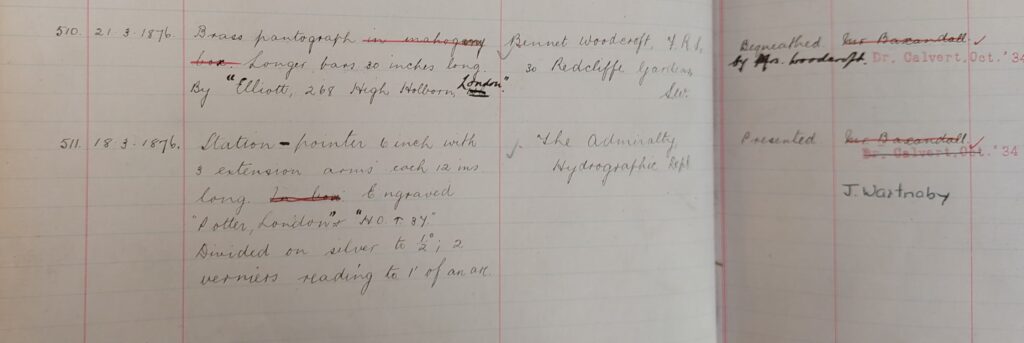
The two entries in the inventory ledger illustrated from March 1876 show retrospectively when two (retained) items were first included in the South Kensington Museum’s Collections early in the process of assembling the Loan Collection of Scientific Apparatus. Information on Mrs Woodcroft’s bequest of her husband’s William Elliott-made brass pantograph (item 1876-510), originally included 21 March 1876, appears to have been added at a later date, presumably after Bennet Woodcroft died in 1879. By contrast, the Admiralty Hydrographic Department’s 6-inch pointer dial (item 1876-511) made by Potter of London, registered on 18 March 1876, was simply recorded as ‘presented’ i.e. donated, presumably soon after the Loan Collection was dismantled in 1877.
Aftermath – why did some loans become donations, and some not?
As is evident in the particular fate of loans by women contributors, but also as was conventional for a Victorian loan exhibition, the large majority of scientific apparatus displayed in the latter half of 1876 was returned to the original lenders. When we look at the minority of the Loan Collection that was somehow retained in South Kensington – transmuted from loan to donation – the Science Museum archives’ ledger entries for 1876 are revealing. The items of ‘scientific apparatus’ that passed into the Museum’s permanent care were more characteristically older items of historic interest bestowed (or arguably discarded) by the great departments of state such as the Admiralty and the Meteorological Office. Indeed, when we look at which scientific instruments were retained, very few indeed – except the cases listed above – are listed as manufacturers’ donations. We find instead mostly instruments of past significance to government-sponsored research efforts which are listed with other government donations. For example, 1876-820 is a deep-sea thermometer made by Casella, but presented as part of an Admiralty-sponsored collection of objects related to deep exploration, as it was previously used aboard HMS Challenger. Why exactly these objects were retained, and questions concerning object retention more generally, are topics for a planned future research project to mark the 1876 Collection’s 150th anniversary. But one clear working hypothesis to explore is that a plausible explanation for some artefacts being donated rather than recalled was that they had come to the end of their useful working life but were too highly cherished by civil servants for them to be discarded or recycled.
The permanent collection objects listed as acquired from the 1876 Loan Collection were therefore not mostly the result of commercial manufacturers donating recently made ‘modern’ instruments. Most scientific instrument makers would likely have treated the 1876 Loan Exhibition as an opportunity to advertise their newest models, with the intention to retrieve them at a later date for commercial sale. One might initially have thought otherwise from a contemporary article in Nature (1876c, p 42) that is cited by Bud, and which was almost certainly written by Norman Lockyer as a Collection organiser and editor of Nature. While discussing whether some internationally sourced loan items might remain in Britain, that particular Nature editorial piece hopes that the most modern scientific instruments in particular would be donated permanently, even suggesting that ‘many’ instrument makers had ‘signified their willingness to present the nation with their exhibits out of hand’. No specific manufacturers are named, and no follow up article bears out this forecast, however; so little store can be set by Norman Lockyer’s utopian speculations.
Indeed, after the exhibition closed, we see a rather different account on the aftermath of the ‘Loan Collection of Scientific Apparatus’ in The Times newspaper on 3 April 1877. This editorial reports that the ‘number of exhibitors at the Loan Exhibition of Scientific Apparatus who allow their apparatus to remain pending the decision of the Government as to a permanent Science Museum is over 160’, many of whom contributed several objects (Anon, 1877b). What this article did not stress is that these 160 potential donors willing to make their loans into permanent donations constituted only a small subset (a mere eight per cent) of the original 1,200 loan exhibitors.[39] Indeed, from checking available records in the Science Museum inventory ledger, it seems that not all of these post-exhibition offers of permanent donation were actually accepted (and, in fact, some acceptances were later reversed with returns to donors or donations to other museums). Rather it seems that the donation of historically important artefacts from large government organisations – or direct copies of them – was the norm.
These, rather than recent scientific innovations, formed the core of the 1876 corpus of loans-turned-donations. As example of this among the 1876 loans that were accepted by the South Kensington Museum were 76 items of early (1830s–50s) telegraph apparatus discarded from Her Majesty’s Postmaster-General’s Post Office collection.[40] By 1876 these following four examples were already clearly antiques, no longer of any practical value of the Post Office’s telegraph operators, hence apparently bequeathed to the care of the South Kensington Museum:
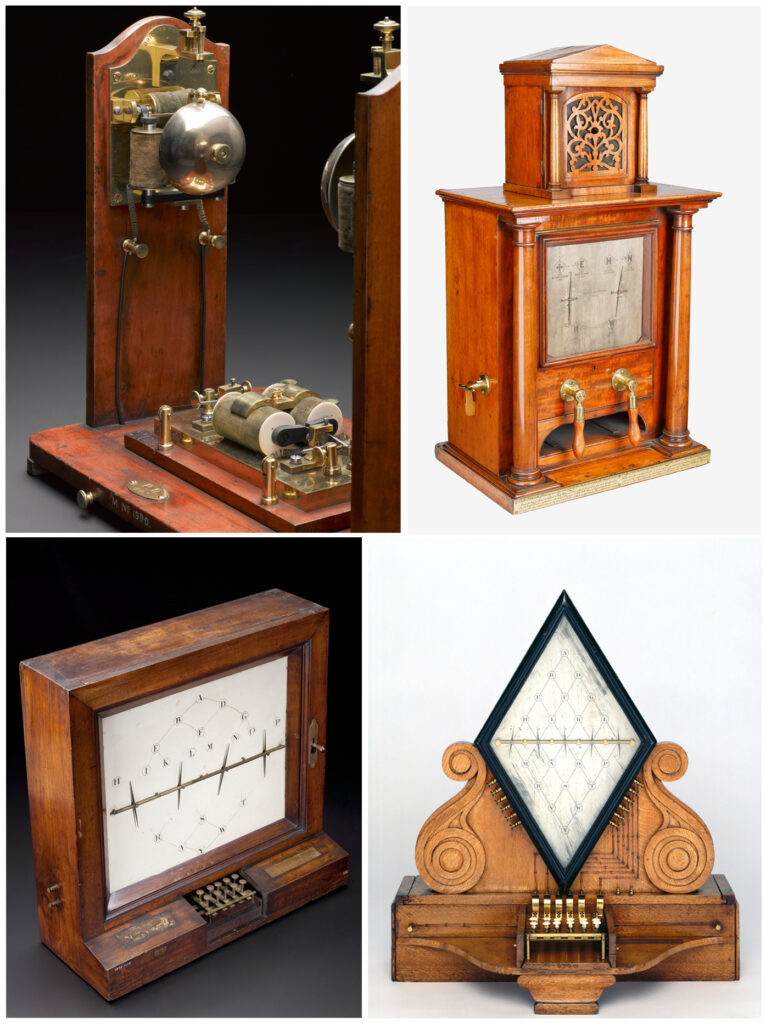
In another example of a department of state apparently offloading apparatus that was obsolete if historically important, the Admiralty Hydrographic Department donated 61 items (five later deaccessioned) such as the HMS Challenger sounding apparatus, compasses, surveying apparatus, and logs of celebrated voyages.[41] The Ordnance Office donated 21 older surveying instruments to the South Kensington collections.[42] By contrast, no evidence has been found of the Museum accepting John Tyndall’s offering of numerous objects, nor indeed of other offers from the Royal Institution, including Faraday’s apparatus and the series concerning Humphry Davy’s experiments on the miner’s safety lamp.[43] Similarly, neither the Messrs. Siemens’ bathometer and attraction meter that were displayed nor James Nasmyth’s drawing of his original Nasmyth hammer were accepted as donations from the Loan Collection (Anon 1877a). This is all evidence in support of our core claim that the list of objects that were returned to owner-exhibitors will be very much longer than any list of what was retained at South Kensington after the closure of the 1876 Loan Collection of Scientific Apparatus.[44]
Conclusion
This article has shown the value of looking at the 1876 South Kensington Loan Collection of Scientific Apparatus from the perspective of the lenders, without presuming any necessary pathway to donation. That Loan Collection was a grand form of Victorian public science, in which participants had their own specific reasons for wanting to display their ‘scientific apparatus’, and for then either wanting to donate it or (more commonly) to retain it for their own private use.[45] Another future project, able to operate beyond the restrictions of pandemic lockdowns to access all relevant archival materials, should be able to map more definitively and exhaustively which objects displayed in 1876 might have somehow ended up in the Science Museum collections, and thus arguably be part of its foundation. But following William Preece’s lament that ‘such priceless treasures as were brought together there will never be brought together again’ (Preece, 1882, p 81) we should look to the history of the objects that did not end up being captured in those collections: that is surely just as important a task for any future research project that focuses more than we have been able to do here on the huge European presence at the 1876 Loan Collection, and on the many and varied motivations for participating in such a huge public science venture. Any future research on those non-retained objects, while surely at least as important, will be much more challenging for historians since identifying their locations – and even establishing continued existence – will require intensive and some possibly fruitless research. Yet, if feasible, such a project would reveal the limits of research based exclusively on the current collections held in museums, and how to undertake important research beyond their historically contingent boundaries.
Acknowledgements: Thanks to Tim Boon, Jessica Bradford, Emily Rees, Kate Steiner, and Science Museum archivists and two anonymous referees for their assistance in researching and revising this paper. Parts of this paper were contributed by Alexander King and Nela Spurna as part of their placement work for the Science Museum in spring 2022 on the University of Leeds module HPSC 5000M ‘External placement’. This research was undertaken remotely in pandemic conditions using digitised resources on Science Museum archival collections, kindly supplied by Tim Boon.
Data Access Statement: In compliance with UKRI and University of Leeds data access requirements, all materials cited in this publication can be obtained either from published sources listed in the bibliography, or from the Science Museum Archives, with contact details here: https://www.sciencemuseum.org.uk/researchers/library-and-archives-national-collections-centre
Archival Sources
Science Museum Inventory of Objects (1876 volume) held in the Science Museum Archives
Appendix 1: Comparison of present-day Science Museum holdings with items listed in article 'Loan Collection of Scientfic Apparatus', The Times (3 April, 1877, p.8)
Loan Collection of Scientific Apparatus that appeared to become donations.
*The Astronomer Royal (Airy), set of instruments used in the transit of Venus expedition;
(only photographs of these kept)
[1876-1043 deaccessioned and returned to owner in 1920]
*The Admiralty, Challenger sounding apparatus, compasses, surveying apparatus, and logs of
celebrated voyages;
[61 records credited to the Admiralty Hydrographic department – 5 deaccessioned] 1876-511; 800 to 837; 988-993; 1189; 1206; 1207; 1208; 1209; 1444; 1445]
*The India Office, maps, photographs of Indian trigonometrical surveying instruments
[1876-767 (maps) credited to secretary of state for India, deaccessioned – sent to Hull Museum]
*Her Majesty’s Postmaster-General’s historical series of telegraph apparatus
[76 records in total listed as credited to HM PMG. Including 1876-1282 Highton’s single needle telegraph; 91; 1272 to 1274; 1876-1276; 1277; 1279; 1281-1300; 1304-1320; 1325-1339; 1348; 1350; 1376; 1450; 1451; 1455; 1488; 1517-1527.] images 1286; 1276; 1272; 1274
The Quartermaster-General, maps and plans;
The Royal Institution, Faraday’s apparatus, series of Davy’s experiments on the safety lamp
*Royal Polytechnic institution, large induction coils and Leyden jars
[1876-18 – permanent collection]
Professor Tyndall, original apparatus NOTHING
* Sir W Thomson, tide calculating machine, illustration of wave motion, electrometers;
[21 records in total credited to him. 1876-29 to 31; 34; 40; 41; 48; 68; 735 to 740; 1129; 1343
(Plus probably: 1876-66 Sir W Thomson’s PORTABLE ELECTROMETER).
Images: 1876 –1343 double curb transmitter; NB. meteorological office also donated 1876-788 Kelvin’s ring electrometer]
*Mr Stanley, complete set of all instruments used in architectural, mechanical or engineering drawing
[There is a lot from this in the collection (153 credited donations – so I won’t list all here) including 1876-309/1; 309/2; 979; 631; 632; 636; 661; 633; 634; 637; 543; 284/8; 639/2 and many more!]
See https://collection.sciencemuseumgroup.org.uk/people/ap26625/w-f-stanley-and-company-limited
*Professor Herschel, earliest attempts to photograph on glass, heliostat mirror, polishing machine;
[8 records. 1876-1019 polishing machine (on display in making of the modern world); 1020 pt 1 and 2; 565 spectroscope; 566 heliostatic mounting; 567; 951; 1000]
*Mr Woodcroft, models of engines and machines
[Bennet Woodcroft bequest has 40 records, including 1876-1269 locomotive engine model (on display Making of the Modern World); 1353; 1353/2; 1416; 1494 (on display in making of the modern world); 1528; 15 have been deaccessioned]
*Mr H C Sorby, microscopic sections of rocks
[7 records from H C Sorby – five listed as loans: historic (1876-1; 614; 615; 615 pt 1; 615 pt 2), 2 deaccessioned (1099; 1100)]
Messrs. Siemens, bathometer and attraction meter;
*Ordnance Office, surveying instruments
[21 credited to OS: 769; 1190; 1201; 1202; 1203; 1203/6; 1203/7; 1203/8; 1203/9; 1203 pt 1-5; 1204; 1204 pt 1 and 2]
Mr Nasmyth, drawing of original Nasmyth hammer
*Master of the Mint, assay apparatus
[Five records: 1876-3 to 6 (7 has been deaccessioned)]
Microscopical Society, early microscopes;
*Dr Mann, electrometer
[Seven records 1876-865; 866; 869 categorised as loans: historic, including Rhe electrometer; 1876-867; 868; 1031;1107 categorised as deaccessioned]
* Sir W Grove, original nitric acid battery;
[1876-82 categorised as loans: historic]
Mr Culley, unique specimen of Cooke and Wheatstone’s first telegraph line –
*Mr C Brooke – self-recording magnetometers
[12 records: 1876-841 to 847; 1456; mostly categorised at loans: historic. other images: 841/5; 841 pt2/1]
*Major-General Babbage, Viscount Mahon’s calculating machine (1776)
[Two entries from him – 1876-371 (photograph) and 1876-1405 (light apparatus) deaccessioned – no mention of this calculating machine though]
*Aeronautical Society, dynamic anemometer
[1876-1216 – pressure gauge (loan) – is this the same thing?]
Mr Buchan, instruments used by the Scottish Meteorological Society
*Dr L Brunton, series of physiological apparatus;
[1876-1139 – levers for dissecting frog – deaccessioned]
*Rev N Brady, Wollaston’s reflecting goniometer belonging to the late Dr Whewell;
[goniometer 1876-870]
*Mr Bosanquet, enharmonic harmonium;
[1876-473 permanent collection]
*Dr Andrews, apparatus to exhibit the properties of gases and liquids under different conditions of pressure and temperature, and apparatus employed in studying the continuity of liquid and Gaseous states of matter;
[1876-1047 – permanent collection]
Mr C W Cooke, the original “thunder house” made by Priestley
*Mr Curwen, General Thompson’s enharmonic organ.
[Possibly not the same but there is keyboard for General Thompson’s enharmonic organ 1876-602, credited to J. Robson and co.]
In addition to these are a large number of the more ordinary apparatus illustrating experiments in light, heat, electricity, sound, etc.
*Among the gifts that have been made are several from other countries. The Archaeological Museum of Madrid has sent plaster reproductions of very early astronomical instruments [one remaining 1876-322] and a reproduction of a chart made by Columbus’s pilot [1976-1210 deaccessioned].
*The Instituto di Studii Superiori of Florence presents photographs of ancient instruments and a copy of the drawing representing the first idea of the application of the pendulum to the clock, dictated by Galileo to his son [two still in collection – 1876-1428 and 1876-1453].
There are also some 20 other sets of presents from abroad. Reproductions have been made, by permission, of several pieces of apparatus that were in the collection on loan and are now returned – e.g. Tycho Brahe’s quadrant, Otto von Guericke’s air pump and the Magdeburg hemispheres [photograph remains 1876-586], the first microscope of Jansen, Gravesanude’s heliostat, and Ampère’s apparatus for investigating electrical induction. There is altogether a very fair nucleus for a permanent museum,
Tags
Footnotes
For criticism of the Catalogue’s first (incomplete) edition see The Athenaeum June 17 1876 (Anon, 1876k). Back to text

